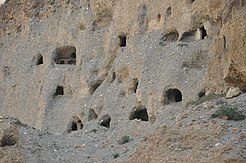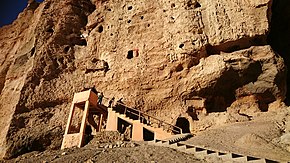
The Red "Lady" of Paviland is an Upper Paleolithic partial male skeleton dyed in red ochre and buried in Wales 33,000 BP. The bones were discovered in 1823 by William Buckland in an archaeological dig at Goat's Hole Cave which is a limestone cave between Port Eynon and Rhossili on the Gower Peninsula, near Swansea in south Wales. Buckland believed the skeleton was a Roman era female. Later, William Solace examined Goat's Cave Paviland in 1912. There, Solace found flint arrow heads and tools and correctly concluded that the skeleton was in fact a male hunter-gatherer or warrior during the last Ice Age.

The Mogao Caves, also known as the Thousand Buddha Grottoes or Caves of the Thousand Buddhas, form a system of 500 temples 25 km (16 mi) southeast of the center of Dunhuang, an oasis located at a religious and cultural crossroads on the Silk Road, in Gansu province, China. The caves may also be known as the Dunhuang Caves; however, this term is also used as a collective term to include other Buddhist cave sites in and around the Dunhuang area, such as the Western Thousand Buddha Caves, Eastern Thousand Buddha Caves, Yulin Caves, and Five Temple Caves. The caves contain some of the finest examples of Buddhist art spanning a period of 2,000 years.

Upper Mustang is an upper part of Mustang District, which is located in Nepal. The Upper Mustang was a restricted kingdom until 1992 which makes it one of the most preserved regions in the world, with a majority of the population still speaking traditional Tibetic languages. Tibetan culture has been preserved by the relative isolation of the region from the outside world. Life in Mustang revolves around tourism, animal husbandry, and trade.
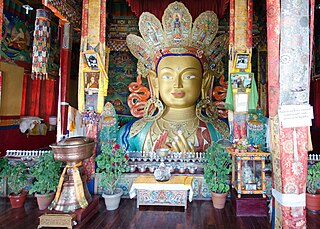
The vast majority of surviving Tibetan art created before the mid-20th century is religious, with the main forms being thangka, paintings on cloth, mostly in a technique described as gouache or distemper, Tibetan Buddhist wall paintings, and small statues in bronze, or large ones in clay, stucco or wood. They were commissioned by religious establishments or by pious individuals for use within the practice of Tibetan Buddhism and were manufactured in large workshops by monks and lay artists, who are mostly unknown. Various types of religious objects, such as the phurba or ritual dagger, are finely made and lavishly decorated. Secular objects, in particular jewellery and textiles, were also made, with Chinese influences strong in the latter.

A thangka is a Tibetan Buddhist painting on cotton, silk appliqué, usually depicting a Buddhist deity, scene, or mandala. Thangkas are traditionally kept unframed and rolled up when not on display, mounted on a textile backing somewhat in the style of Chinese scroll paintings, with a further silk cover on the front. So treated, thangkas can last a long time, but because of their delicate nature, they have to be kept in dry places where moisture will not affect the quality of the silk. Most thangkas are relatively small, comparable in size to a Western half-length portrait, but some are extremely large, several metres in each dimension; these were designed to be displayed, typically for very brief periods on a monastery wall, as part of religious festivals. Most thangkas were intended for personal meditation or instruction of monastic students. They often have elaborate compositions including many very small figures. A central deity is often surrounded by other identified figures in a symmetrical composition. Narrative scenes are less common, but do appear.

Sky burial is a funeral practice in which a human corpse is placed on a mountaintop to decompose while exposed to the elements or to be eaten by scavenging animals, especially carrion birds like vultures and corvids. Comparable excarnation practices are part of Zoroastrian burial rites where deceased are exposed to the elements and scavenger birds on stone structures called Dakhma. Sky burials are endemic to Tibet, Qinghai, Sichuan, and Inner Mongolia, as well as in Mongolia, Nepal, Bhutan, and parts of India such as Sikkim and Zanskar. The locations of preparation and sky burial are understood in the Vajrayana Buddhist traditions as charnel grounds. Few such places remain operational today, as the Chinese Communist Party initially banned the practice completely during the Cultural Revolution as feudal superstition, and continues to restrict the practice due to its allegations of decimation of vulture populations.
Disposal of human corpses, also called final disposition, is the practice and process of dealing with the remains of a deceased human being. Disposal methods may need to account for the fact that soft tissue will decompose relatively rapidly, while the skeleton will remain intact for thousands of years under certain conditions.

The Gandaki River, also known as the Narayani and Gandak, is one of the major rivers in Nepal and a left-bank tributary of the Ganges in India. Its total catchment area is 46,300 km2 (17,900 sq mi), most of it in Nepal. In the Nepal Himalayas, the Gandaki is notable for its deep canyon. The basin also contains three mountains over 8,000 m (26,000 ft), namely Dhaulagiri, Manaslu and Annapurna Massif. Dhaulagiri is the highest point of the Gandaki basin. In its upper reaches, the river is known as Kali Gandaki as it flows through the Mustang district and the famous Kali Gandaki Gorge in Nepal. When the river reaches the Terai plains of Nepal, it is referred to as the Narayani River. This name change typically occurs near the confluence with the Trishuli River at Devghat in Chitwan. Upon entering India, the river is known as the Gandak River.

Mustang District is one of the eleven districts of Gandaki Province and one of seventy-seven districts of Nepal which was a Kingdom of Lo-Manthang that joined the Federation of Nepal in 2008 after abolition of the Shah dynasty. The district covers an area of 3,573 km2 (1,380 sq mi) and in 2011 had a population of 13,452. The headquarters is located at Jomsom. Mustang is the fifth largest district of Nepal in terms of area.
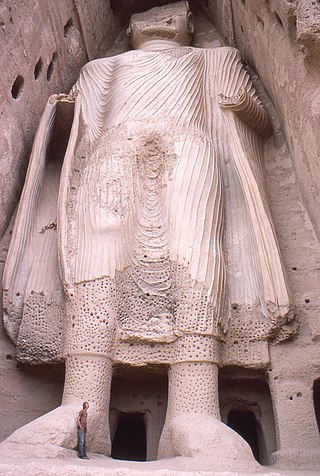
Buddhism, a religion founded by Gautama Buddha, first arrived in modern-day Afghanistan through the conquests of Ashoka, the third emperor of the Maurya Empire. Among the earliest notable sites of Buddhist influence in the country is a bilingual mountainside inscription in Greek and Aramaic that dates back to 260 BCE and was found on the rocky outcrop of Chil Zena near Kandahar.

Lomanthang is a rural municipality in Mustang district in Gandaki Province of western Nepal. It is located at the northern end of the district, bordering the Tibet Autonomous Region of China to the north and Dalome rural municipality of Mustang in the south.

Tibetan Buddhist architecture, in the cultural regions of the Tibetan people, has been highly influenced by Nepal, China and India. For example, the Buddhist prayer wheel, along with two dragons, can be seen on nearly every temple in Tibet. Many of the houses and monasteries are typically built on elevated, sunny sites facing the south. Rocks, wood, cement and earth are the primary building materials. Flat roofs are built to conserve heat and multiple windows are constructed to let in the sunlight. Due to frequent earthquakes, walls are usually sloped inward at 10 degrees.

A kapala is a skull cup used as a ritual implement (bowl) in both Hindu Tantra and Tibetan Buddhist Tantra (Vajrayana). Especially in Tibetan Buddhism, kapalas are often carved or elaborately mounted with precious metals and jewels.
Charles Albert Edward Ramble is an anthropologist and former University Lecturer in Tibetan and Himalayan Studies at the Oriental Institute, Oxford University. Since 2009 he has been Professor and Directeur d'études at the Ecole pratique des hautes études, Paris. Between 2006 and 2013 he was elected president of the International Association for Tibetan Studies (IATS) and convened the 10th seminar of IATS at Oxford in 2003.

Kagbeni is a village in the Baragung Muktikshetra rural municipality of Mustang District of the Himalayas, in Nepal, located in the valley of the Kali Gandaki River. At the time of the 2011 Nepal census, it had a population of 555 people. The village lies on the trail from Jomsom to the royal capital Lo Manthang, near the junction with the trail to Muktinath. Kagbeni is also regarded as one of the oldest villages in the Himalayas. Kagbeni lies between two sacred rivers muktinath and kaligandaki. The major touristic spot of Kagbeni includes Lhungfu Cave, Kag Chode Thupten Samphel Ling Gompa, Kag Khar Palace, and Devthen Chhorten.
The Red Lady of El Mirón is a skeleton belonging to a woman of Upper Paleolithic (Magdalenian) found at El Mirón Cave in eastern Cantabria, Spain.
This page lists major archaeological events of 2018.

Thubchen Lhakang Monastery is a 15th-century Buddhist monastery located in Lo Manthang, Upper Mustang, Nepal. The monastery has ancient wall paintings drawn with hues of turquoise, malachite, cinnamon and gold. These walls were damaged but restored later by King Mahendra Trust for Nature Conservation and American Himalayan Foundation in 1999.
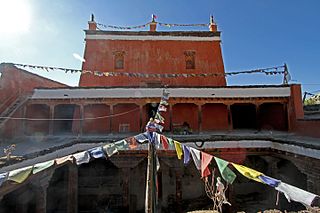
Jampa Lhakang Monastery, also called Maitreya Temple, is a Buddhist monastery located in Lo Manthang, Upper Mustang in Nepal. It was thought to be built in the 11th century AD but later verified to be built in the 15th century AD and contains the world's largest collection of mandalas painted on its walls. The earthquake of April 2015 severely damaged these paintings and 500-year-old frescos of the floors. The American Himalayan Foundation and Lo Gyalpo Jigme Cultural Conservation Foundation are helping to recover these damages.
Lo Manthang Palace is a historical palace in Nepal. It is located in 3800 m above sea level in Lomanthang Rural Municipality of Mustang district. The palace is under consideration to be listed in UNESCO World Heritage site.


